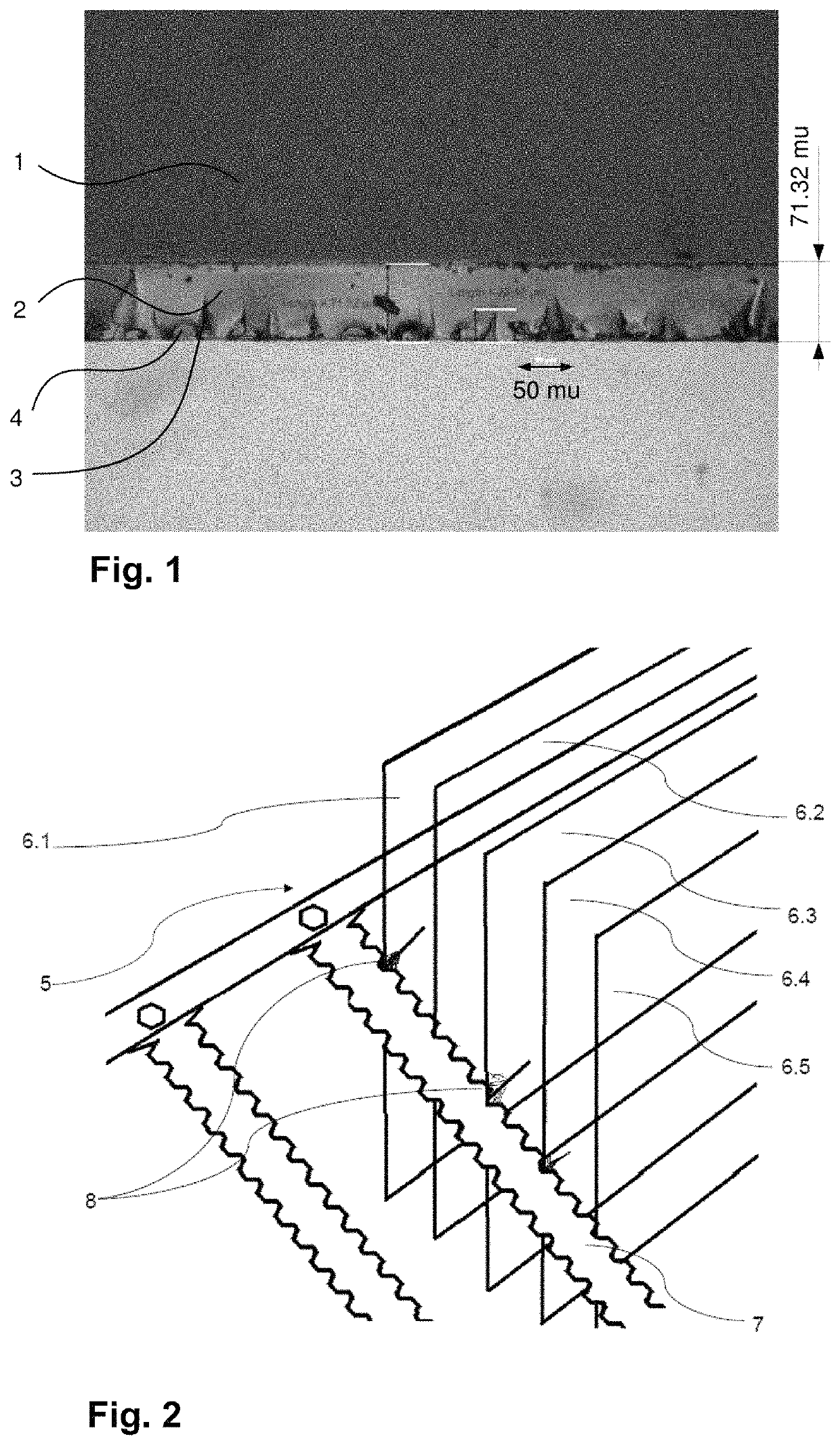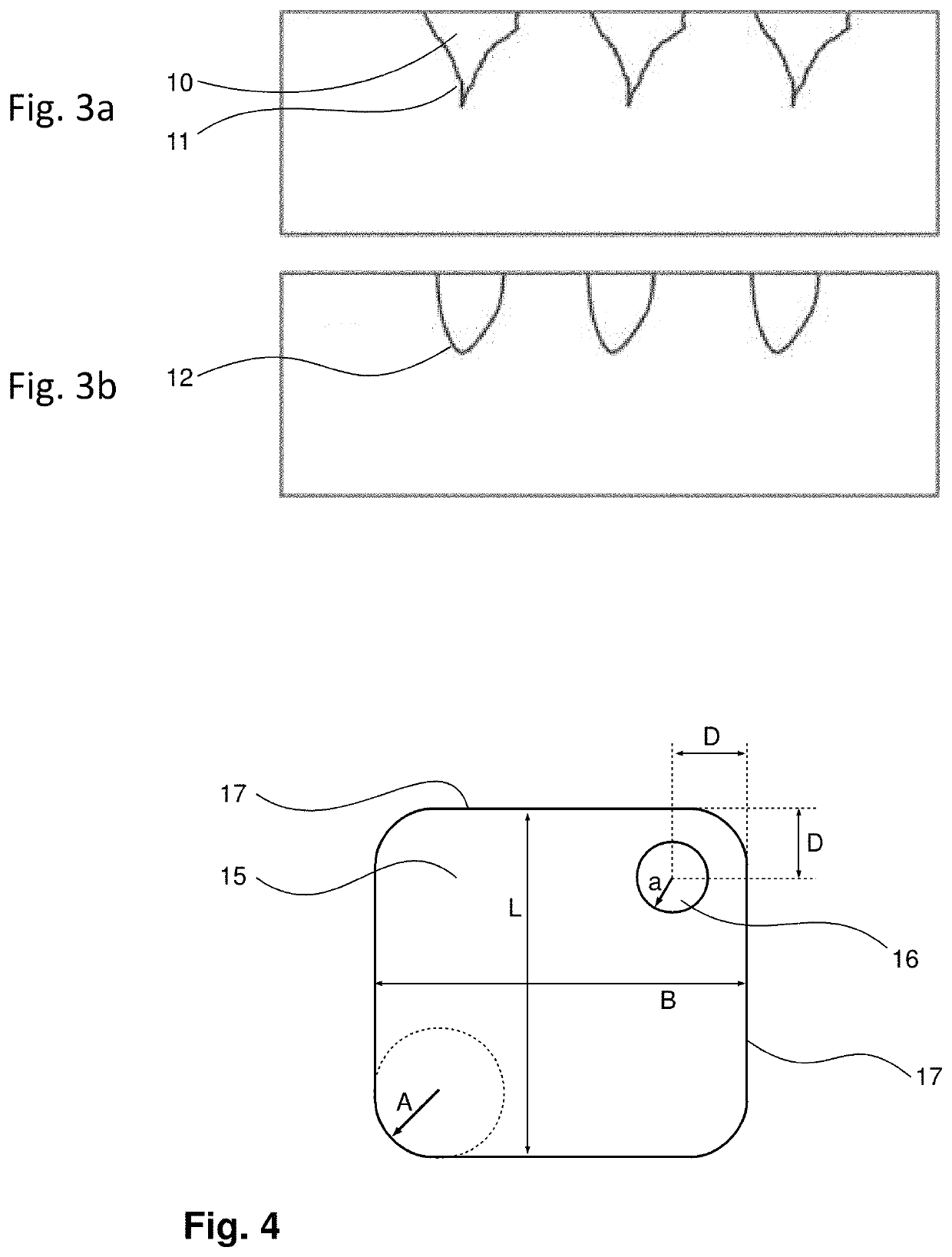Ultrathin chemically toughened glass article and method for the production of such a glass article
a technology of chemically toughened glass and ultrathin, which is applied in the direction of web handling, thin material handling, transportation and packaging, etc., can solve the problems of increasing the probability of breakage, difficult to achieve sheet thicknesses less than 0.5 mm, and handling and processing ultrathin, etc., to achieve the effect of compact coil size, low probability of long-term breakage, and improved overall yield of the whole process using glass ribbon as a starting material
- Summary
- Abstract
- Description
- Claims
- Application Information
AI Technical Summary
Benefits of technology
Problems solved by technology
Method used
Image
Examples
example 1
[0160]Glass with a composition according to example 1 in Tables 1 / 2 is produced by a down-draw method and cut into 440 mm×360 mm×0.1 mm glass sheets. These sheets were then cut with a 100° Penett diamond cutting wheel with 360#teeth. 40 samples with dimensions 50 mm×50 mm (see FIG. 4, L=50 mm, B=50 mm), 142 mm×75 mm (see FIG. 4, L=142 mm, B=75 mm), and 300 mm×200 mm (see FIG. 4, L=300 mm, B=200 mm) were cut. The samples were provided by means of a CO2 laser with one circular hole (16, FIG. 4) with a radius of a=5 mm and four rounded corners with radius A=10 mm as shown in FIG. 4. The samples were also provided with four R5 corners (the radius of the corner is 5 mm) as shown in FIG. 4. In addition, 60 pieces 20 mm×50 mm×0.1 mm were cut. The edges of half of the amount of the as-cut samples were etched by NH4HF2 solution (edge pre-treatment). The etching amount was around 1 μm. All samples were chemically toughened in 100% KNO3 for 15 hours at 430° C. The pre-etched and toughened samp...
example 2
[0164]Glass with a composition according to example 2 in Tables 1 / 2 is produced by a down-draw method and cut into 440 mm×360 mm×0.1 mm glass sheets. The glass sheets were then cut with a 100° Penett diamond cutting wheel with 360#teeth. 40 samples with dimensions 50 mm×50 mm (see FIG. 4, L=50 mm, B=50 mm), 142 mm×75 mm (see FIG. 4, L=142 mm, B=75 mm), and 300 mm×200 mm (see FIG. 4, L=300 mm, B=200 mm) were cut. The samples were provided with one circular hole (16, FIG. 4) with a radius of a=5 mm and four rounded corners with radius A=10 mm as shown in FIG. 4.
[0165]In addition, 90 pieces 20 mm×50 mm×0.1 mm were cut. The edges of 60 pieces of the as-cut samples were etched by NH4HF2 solution for 5 min (edge pre-treatment). The etching amount is around 1 μm. Then 30 samples were chemically toughened in 100% KNO3 for 3 hours at 400° C. The pre-etched and toughened samples were also post-etched after toughening (post-treatment). 30 samples were only chemically toughened without any pre-...
example 3
[0177]Glass with a composition according to example 3 in Tables 1 / 2 is produced by a down-draw method and cut into 440 mm×360 mm×0.1 mm glass sheets. These sheets were then cut with a 100° Penett diamond cutting wheel with 360#teeth. 40 samples with dimensions 50 mm×50 mm (see FIG. 4, L=50 mm, B=50 mm), 142 mm×75 mm (see FIG. 4, L=142 mm, B=75 mm), and 200 mm×300 mm (see FIG. 4, L=300 mm, B=200 mm) were cut. The samples were provided with one circular hole (16, FIG. 4) with a radius of a=5 mm and four R5 corners (A=10 mm) as shown in FIG. 4. In addition, 60 pieces with dimensions 20 mm×50 mm×0.1 mm were cut. The edges of half of the amount of the as-cut samples were etched by NH4HF2 solution (edge pre-treatment). The etching amount is around 1 μm. All samples were chemical toughened in 100% KNO3 for 2 hours at 420° C. The pre-etched samples were also post-etched after toughening (post-treatment). The remaining 30 samples were only chemically toughened without any edge pre- or post-t...
PUM
| Property | Measurement | Unit |
|---|---|---|
| surface compressive stress CS | aaaaa | aaaaa |
| surface compressive stress CS | aaaaa | aaaaa |
| surface roughness | aaaaa | aaaaa |
Abstract
Description
Claims
Application Information
 Login to View More
Login to View More - R&D
- Intellectual Property
- Life Sciences
- Materials
- Tech Scout
- Unparalleled Data Quality
- Higher Quality Content
- 60% Fewer Hallucinations
Browse by: Latest US Patents, China's latest patents, Technical Efficacy Thesaurus, Application Domain, Technology Topic, Popular Technical Reports.
© 2025 PatSnap. All rights reserved.Legal|Privacy policy|Modern Slavery Act Transparency Statement|Sitemap|About US| Contact US: help@patsnap.com



